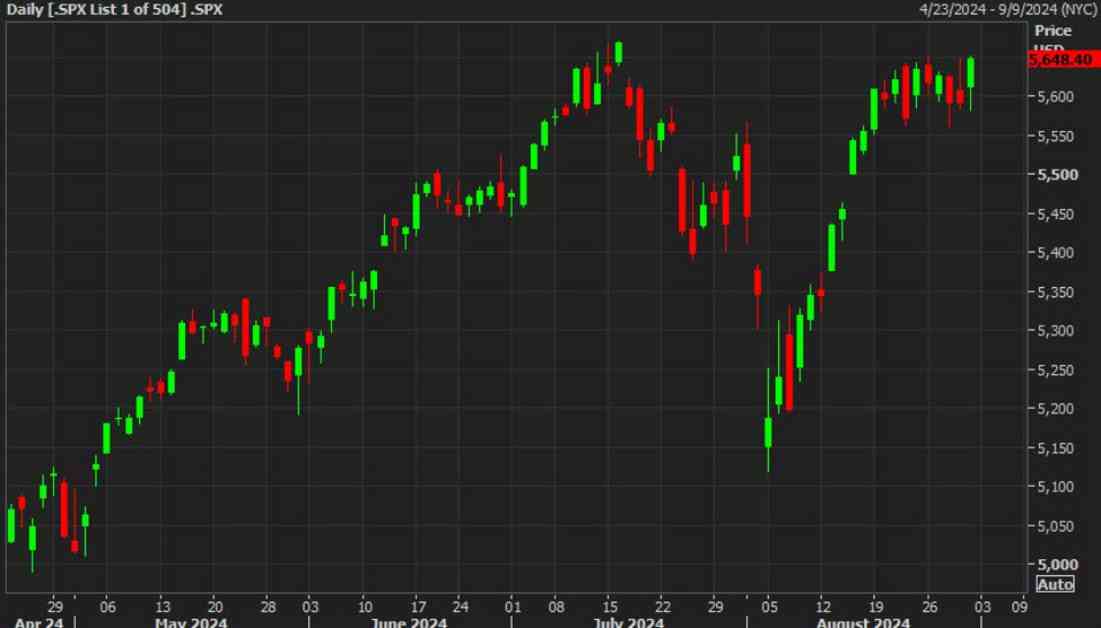US Stock Markets Rally in Late-Day Bid as Nasdaq’s Winning Streak Ends
The US stock markets closed out the final day of trading in August with a mix of ups and downs, capping off a volatile month. The S&P 500 opened strong, only to dip into negative territory at midday before rallying in the afternoon and closing with a massive wave of buying late in the day. While some of this activity may have been technical in nature as traders positioned themselves ahead of a long weekend, it marked the end of a lively month in the markets.
Market Performance
The S&P 500 closed the day up 1.0%, while the Nasdaq Composite gained 1.1% and the Dow Jones Industrial Average rose by 0.6%. The small-cap Russell 2000 index also saw a modest gain of 0.3%, and the Toronto Stock Exchange Composite Index climbed by 0.2%. On a weekly basis, the S&P 500 finished with a gain of 0.25%, while the Nasdaq Composite was down 0.9% and the Russell 2000 slipped by 0.4%. The Toronto Stock Exchange Composite Index closed the week with a marginal loss of 0.1%.
Looking at the monthly performance, the S&P 500 posted a gain of 2.3%, the Nasdaq Composite was up 0.6%, and the Dow Jones Industrial Average saw an increase of 1.8%. However, the Russell 2000 index was down 2.0% for the month, and the Toronto Stock Exchange Composite Index posted a modest gain of 0.6%. While these numbers may not appear impressive at first glance, they come on the heels of significant selling pressure at the start of the month.
Nasdaq’s Double Doji
One notable development in the markets was the formation of a double doji pattern on the Nasdaq Composite’s monthly chart. A doji pattern occurs when the opening and closing prices are virtually the same, indicating indecision among traders. A double doji pattern is seen as a potential setup for a significant move in the market. Despite the impressive recovery from the August declines, there remains uncertainty surrounding the market outlook, particularly in light of the recent decline in Nvidia’s stock price and the historically negative seasonal backdrop for September.
Market Analysis
The late-day rally in the US stock markets on the final trading day of August reflected the ongoing volatility and uncertainty that has characterized much of the month. While the S&P 500, Nasdaq Composite, and Dow Jones Industrial Average all closed higher for the day, the mixed performance of smaller-cap stocks and the Toronto Stock Exchange Composite Index underscored the divergent trends in the markets.
The S&P 500’s strong open followed by a midday dip into negative territory highlighted the market’s sensitivity to external factors, such as economic data releases, geopolitical developments, and market sentiment. The late-day surge in buying, while providing a positive end to the month, also raised questions about the sustainability of the market’s upward momentum.
The Nasdaq Composite’s double doji pattern on the monthly chart added a layer of complexity to the market analysis, signaling a potential inflection point in the market’s direction. The pattern suggested that traders were grappling with conflicting signals and struggling to establish a clear trend. The uncertainty surrounding the market outlook was further compounded by the recent decline in Nvidia’s stock price, which had been a key driver of the technology sector’s performance.
The mixed performance of the Russell 2000 and the Toronto Stock Exchange Composite Index reflected the broader market dynamics at play. While the Russell 2000’s modest gain suggested some resilience among small-cap stocks, the index’s overall decline for the month underscored the challenges facing smaller companies in a volatile market environment. Similarly, the Toronto Stock Exchange Composite Index’s marginal gain for the month highlighted the impact of external factors, such as commodity prices and global economic trends, on Canadian equities.
Market Outlook
As investors look ahead to the coming months, the market outlook remains uncertain. The combination of macroeconomic uncertainties, geopolitical tensions, and seasonal factors has created a challenging environment for traders. While the late-day rally in the US stock markets provided a positive end to August, the underlying risks and uncertainties facing the market suggest that volatility is likely to persist in the near term.
The formation of a double doji pattern on the Nasdaq Composite’s monthly chart points to a potential inflection point in the market’s direction. Traders will be closely watching for signs of a breakout from the pattern, which could signal a decisive shift in market sentiment. However, the recent decline in Nvidia’s stock price and the negative seasonal backdrop for September have raised concerns about the sustainability of the market’s upward momentum.
In conclusion, the US stock markets rallied in a late-day bid on the final trading day of August, capping off a volatile month marked by ups and downs. The mixed performance of the major indices, the formation of a double doji pattern on the Nasdaq Composite’s monthly chart, and the ongoing uncertainty in the market outlook point to a challenging environment for traders in the coming months. As investors navigate the complexities of the current market landscape, staying informed and remaining vigilant will be key to navigating the potential risks and opportunities that lie ahead.

















